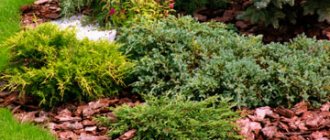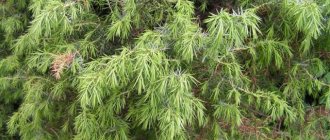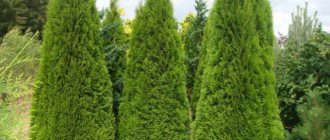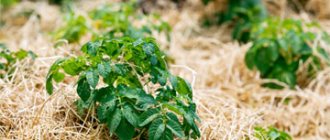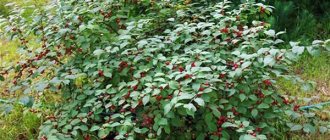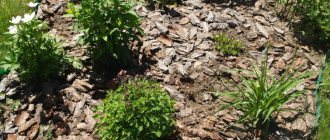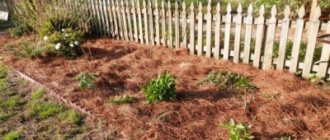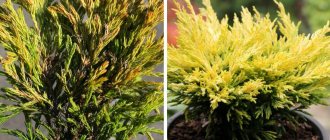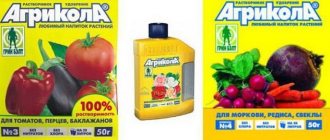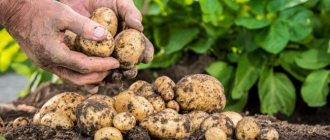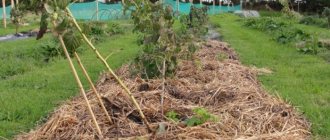Mulching with conifer cones and needles: advantages of using cones as mulch
Fir needles contain calcium, magnesium, manganese and zinc.
Fir or pine cones can be compared to wood mulch. The advantages of using are the following:
- prevent the appearance of crust on the soil surface;
- repel water;
- protect from wind and sun;
- prevent weed germination;
- do not interfere with natural air circulation;
- maintain normal temperature conditions: in winter, under a layer of mulch, heat is retained, and in summer, coolness is maintained.
The disadvantages of mulching with cones include their inaccessibility. It is easier to mulch the soil with grass clippings or leaf litter than to collect several bags of cones in the forest.
Under a layer of cone mulch, the crop is protected from overheating and freezing . Cones are placed between rows or on top of berry crops with the onset of hot weather.
In the table we offer a comparison of pine cone mulch with other types of organic mulch.
| Type of mulch | Comparison with pine cone mulch | Disadvantages of mulch |
| Compost | It has a neutral reaction; when rotting, it saturates the soil with nutrients, and is more useful as a fertilizer than pine cones. Suitable for growing seedlings. | – |
| Manure | Saturates the soil with useful substances, suitable for mulching in winter. | It is advisable to use mixed with straw. |
| Nettle | High content of nitrogen and trace elements. | – |
| Fallen leaves | It has good air and water permeability, just like pine cones. | When wet it rots quickly. Attracts slugs and snails. |
| Straw (⊗ how to mulch with straw in the greenhouse and on the plot) | Unlike cones, it is suitable for all vegetable crops, it also rots slowly and saturates the soil with useful substances. | May contain weed seeds. |
| Cut grass | Unlike cones, it does not acidify the soil and is an organic fertilizer that improves the soil structure. | In rainy weather, when used for berry crops, the fruits rot. Allows the soil to overheat and may have poor water and air permeability. |
| Peat | Suitable for growing vegetable seedlings. | Acidifies the soil. |
| Tree bark and sawdust (⊗ how to mulch) | The material is more accessible for use and takes a long time to rot. It is advisable to use for the winter. | They take nitrogen from the soil. |
| Conifer needles | They rot faster and acidify the soil to a greater extent than cones. | They strongly acidify the soil. |
Recommendations for using pine cones as mulch
I do not use pine cones near buildings or barbecues. Mulch is highly flammable; for safety, mulch beds away from living quarters. When choosing cones, pay attention to their appearance. Green cone-shaped fruits with various spots on the surface are not suitable for use. They may contain fungal spores, which are sources of fungal diseases in the garden.
What is mulching
- Covering the soil surface with pine cones, that is, mulching, performs a number of basic functions:
- protection of the ground cover from direct sunlight;
- moisture retention;
- reducing the frequency of soil loosening.
Did you know? If your dog or cat gets into the habit of digging holes in the flower garden, you need to scatter pine cones in these places. This will serve as a thorny protection against animals.
- Additionally, this process contributes to:
- enrichment of soil with useful elements;
- weed control;
- protection from weathering and soil washout;
- protecting plant roots from freezing in winter and overheating in summer.
To protect the soil from drying out in the summer at the dacha, you can use the fruits of pine trees as mulch . To remove unnecessary growth that has made its way through them, just push them apart with your hand and remove the weeds. When the soil is wet, the cone shrinks, and when the weather is warm and sunny, it opens up and mulches the soil very well, protecting it from drying out. This type of mulching also has a great aesthetic effect. Especially in the autumn, when the plants in the flowerbed are no longer so lush.
Using pine litter as mulch
Pine litter contains branches, cones, needles and small pieces of bark. It is looser, rots faster and saturates the soil with useful substances.
Pine litter is preferably used on poor lands
The advantage of using pine litter is that the soil structure changes; it becomes loose, air- and moisture-permeable.
Tip #2. With regular use of pine litter, the acidity of the soil greatly increases, so it is mixed with fallen leaves or straw. Once every two years they add ash, and in the fall dolomite flour; flour produced by Dubensky Quarry is suitable.
Coniferous plants, some garden flowers and berry bushes are very fond of acidic soils. For example, rhododendrons grow better and develop faster if pine litter is added directly to the soil. 30% of the litter is buried in the ground, and 70% is used as mulch.
When growing cucumbers, tomatoes, onions and other vegetable crops that prefer slightly acidic soils, first sprinkle the ground with ash and then lay mulch. Pine litter is not used for growing seedlings .
Conifer cones and needles are not only good mulch, but also excellent fertilizer. To prevent mulch from strongly acidifying the soil, it is used in combination with organic matter. The mulch is mixed with fallen leaves, compost, hay, grass clippings or plant debris. Pine and spruce litter are more suitable for winter sheltering the soil from rodents and frost. Mulch is combined with non-woven covering materials, for example, lutrasil or organic matter (compost or sawdust).
Where and how to collect material?
Any needles are suitable for mulching, but pine is better than spruce - it acidifies the soil more.
In the garden, you can use litter from any coniferous trees for mulching: spruce, pine, fir, cedar, juniper. The needles of the latter contain the most useful substances.
It is better to collect pine needles for mulching in clean, dry areas in the forest , without diseased plants nearby. You should choose a dry, sunny day for this, or even better if there is no precipitation for several days before collecting the litter.
You can put the litter in large bags, preferably breathable ones in which the needles will not rot. Having delivered it from the forest, it is better to immediately lay it out in the sun to dry. Then you can start mulching. Sources used:
- https://superda4nik.ru/mulchirovanie-hvojnymi-shishkami-i-igolkami/
- https://mr-ogorodnik.ru/ogorod/posadka-i-uhod/hvojnyj-opad-v-sadu-i-ogorode/
- https://prosadiogorod.ru/ogorodnik/sovety/mulchirovanie-shishkami.html
- https://facenewss.ru/ogorod/sposoby-primeneniya-shishek
- https://sadovod.expert/ogorod/plodovyye-ovoshchi/tomat-pomidor/mulchirovaniye/chem-luchshe/sosnovye-shishki-i-hvoya.html
- https://superurozhay.ru/organicheskie-udobreniya/mulcha-iz-shishek-dostoinstva-i-nedostatki.html
How to mulch with pine cones and pine needles?
Pine needles are used to mulch paths in the garden to keep weeds away.
Pine cones are scattered after crop germination. They are scattered in a layer of 10-15 cm around flowers, berry bushes, vegetable crops and fruit trees. When used for annual crops, strawberries or strawberries, the cones are removed from the beds for the winter. Under perennial crops, mulch is left until it rots. Mulch is added as needed, and in the spring it is mixed and loosened.
Pinches on plants
All cones (even fallen ones) tend to open in warm weather and shrink when it gets cold. Depending on the temperature, their scales move away from the center or are pressed against it. This feature often harms trees and shrubs, the soil under which is covered with such mulch.
In warm weather, young trunks and branches can get stuck between the open scales, and when the cone shrinks, a pinch forms on the plant.
If such a disaster occurs to a tree, the matter will end with the appearance of a wound on the bark, which will most likely heal. If the scales shrink around a currant or gooseberry branch, the damage can be much more serious.
Experience of using pine and spruce needles in a garden plot
Every year, mulching with pine needles becomes more and more popular. Needles and cones are used for vegetable and berry crops. Let us consider in the table the effectiveness of using pine needles for different crops.
| Type of culture | Type of mulch | Result |
| Tomatoes | Pine and spruce needles mixed with wood ash. | Acceleration of growth and entry into fruiting, disease resistance, increased yield. |
| Strawberries | Spruce needles combined with compost and sand in equal proportions. | Increased yield by 1.5 times, absence of pests and diseases, large berry size and improved taste. |
| Potato | Fir needles combined with compost and tree bark in equal proportions. | No pests, scab removal even from infected tubers. |
| Onion | Conifer needles and cones. | Loose soil, high humidity, absence of weeds, increased onion yield (from 1 kg of planting material it was possible to obtain 40 kg of onions). |
| Garlic | Plantings are covered with pine needles for the winter, and the mulch is not removed until harvest. | Moisture is retained, the soil is loose, and there are no weeds. |
Drainage in flowerpots with flowers
To create comfortable conditions for indoor plants, special drainage components are used. Drainage provides the necessary humidity and air exchange, for which substances that are structurally larger than the soil (crushed stone, pieces of ceramics, brick or special materials, foam plastic) are placed on the bottom of the flower pot.
The scales of the cones successfully cope with the drainage function. They are separated using tools (nippers) and placed in a pot. You can mix them with foam.
Cones not only provide humidity and air access, but also have a positive effect on the condition of plants due to their bactericidal properties, in addition becoming a source of nutrients.
Since conifers increase the acidity of the soil, spruce drainage is ideal for flowers that prefer a pH level of 4 to 7, such as hydrangeas, asters, chrysanthemums, petunias and rhododendron. For other flowers, add a little charcoal to the pot to neutralize the acidity.
Answers to common questions
When mulching, whole or crushed cones are used.
Question No. 1 . What fertilizers can be used in conjunction with pine needle mulch?
Answer: In summer, the mulch is mixed with humus, compost, or poured with an infusion of mustard and nettle. In autumn, the soil is fertilized with manure or green manure is used. For the winter, the plot is sown with mustard or grains (rye or wheat). After green fertilizer, the soil becomes loose and soft, like feathers.
Question number 2 . When to plant cones for strawberries and wild strawberries, in autumn or spring?
Answer: There is no point in planting cones in the fall or early spring, as soon as the snow has melted. The soil must dry out so that pests do not grow under the mulch layer and diseases do not multiply. As soon as the soil dries sufficiently, the strawberry leaves and ovary appear, then the cones should be laid. The layer is about 10 cm. If you need to mulch the tendrils, then reduce the thickness of the layer.
Question number 3 . Is it possible to reuse needles and cones next year?
Answer: Yes. If the cones and needles are not saturated with moisture and the mulch has not begun to rot, then in the fall they are put in bags and stored in a dry room until spring.
Question number 4 . Is it true that ants often live in the mulch of their needles?
Answer: The relationship between spruce mulch and the appearance of ants in the garden plot has not been fully studied, but one thing is known for sure. Together with the needles and cones, forest ants are brought from the forest, which, unlike garden ones, will dig up the entire area. Be careful when collecting pine litter.
What mulch should not be used?
Coniferous mulch can cause harm only if it is used uncontrollably for many years in a row - the earth can become too acidic.
It is better not to use fresh pine needles. Drying in the sun for several days is a must.
Fungus brought along with raw needles or infected cones can also cause harm. This is why it is very important to collect material in dry times. Make sure there are no uninvited guests - forest ants.
It is better to mulch with pine needles only those beds that are located far from the barbecue and other sources of fire , since this material ignites quickly.
If the needles are dry, one spark that falls on it is enough to cause a fire in the garden bed or flowerbed. Be careful!
Mistakes gardeners make when mulching with pine needles and cones
Common mistakes:
- Gardeners use needles as mulch for all crops on the site. Conifer cones and needles acidify the soil, so they are not used for crops that prefer an alkaline reaction. There are other types of mulch, such as straw and fallen leaves, which do not affect the acidity of the soil in any way;
- Gardeners leave mulch on the site all year round. This cannot be done if the soil acidity is high. The needles are removed from the site in August, and the beds are covered again in early spring. In autumn, worms process needles, which causes the earth to become acidic;
- Along with coniferous litter, which is used as mulch on currants, strawberries, gooseberries, apple trees and other fruit trees, fungal diseases occur: rust, mold, root rot and others. Diseases of coniferous trees spread to garden crops, so before using the mulch, apply any fungicide, for example, Aktoverm or Fitoverm.
Rate the quality of the article. We want to be better for you:
Advantages and disadvantages
Experts recommend using pine cones to mulch gardens, as they contain many microelements beneficial for plants. In addition, such natural material has numerous advantages:
- Does not get blown away by strong winds and does not get wet.
- The mulch lies evenly on the beds and does not compact the soil.
- It has a powerful bactericidal effect, which protects the plant from damage by pests and diseases.
- The growth and development of culture is accelerating.
- Pine cones are excellent at repelling snails and slugs.
- The natural access of oxygen and moisture is not disrupted. Even under mulch, the soil warms up quickly.
- Soil fertility increases.
It is also worth considering that if such mulch is used for the winter, then a small layer of foliage and rotted manure must be placed under it. Only in this case can high-quality soil fertilization be ensured.
Since the cones decay slowly, it is better not to use them for annual plants, because they will not have time to receive the required amount of nutrients. For such crops, it is better to use compost or quickly decomposing mulch. Whole pine cones are quite large and difficult to obtain even in a large forest.
This natural material simply cannot be used for mulching walkways due to its high resin content and irregular shape. The presence of these characteristics makes the cone-shaped cones slippery, which is dangerous for pedestrian traffic.
How else to use pine cones in the country
- Pine cones can be used as drainage when planting hydrangeas, rhododendrons, and coniferous garden plants. They can also be used to mulch the tree trunks of these plants. Azalea and blueberry will also not mind such mulch.
- Cones and pine litter are also suitable for mulching roses. Only under a layer of such bedding you first need to scatter a layer of wood ash (to neutralize high acidity). Such a shelter is not only practical, but also looks elegant!
- Pine cones are suitable for lighting a barbecue or stove (if used frequently, the chimney may become clogged due to the resin content); they will provide additional heat and a pleasant forest aroma. They have long been used in Rus' to fire up a samovar.
- Pine cone jam. With the arrival of May, collect young pine cones, cut them in half, fill them with boiled water and let them brew for 24 hours. Then add sugar to the mixture in a 1 to 1 ratio and place everything on low heat for 2 hours (after boiling). If available, be sure to supplement the contents with lemon juice and cinnamon. As a result, you should get a very tasty brown jam with a pine aroma and a liquid consistency. It is especially recommended for people with reduced immunity (for example, with a cold), as well as for thinning the blood. One minus - it ends quickly!
- You can grease the most beautiful cones with PVA glue and sprinkle evenly with glitter (shiny powder, which can be purchased at flower shops). You will get wonderful Christmas tree decorations.
Use that is not recommended
Despite the extensive list of possible uses for pine cones, there are some aspects that prohibit their use. Below are examples of when a pine cone can cause harm:
- You should not store them in the house, because harmful microorganisms can live inside the dried pine cone.
- It is also prohibited to add pine cones to compost. They can cause pests and inhibit the development of beneficial microorganisms and worms.
- It is not recommended to sprinkle cone chips on the paths of personal plots. Perhaps from a distance it will look very beautiful and creative, but after the first rain, the slivers will turn into small hard tubercles, through which you can easily trip and even get hurt if you fall.
On a note! Under no circumstances should you place pine cones near a fire. One spark is enough to start a fire.
